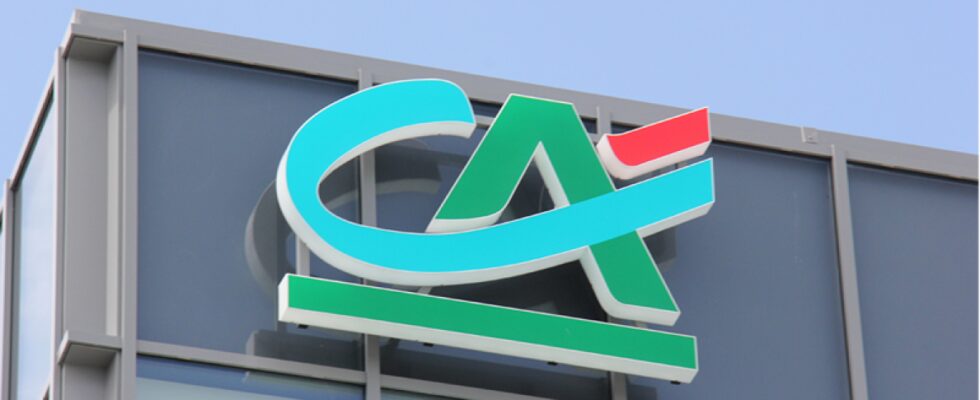(BFM Bourse) – The American establishment has gone from “underweight” to “online weighting” on the listed structure of Crédit Agricole but sees even more potential in Société Générale.
French banks remain a relatively unloved sector on the stock market, with a significant discount compared to their American counterparts. BNP Paribas and Crédit Agricole SA trade for around 6 times expected twelve-month earnings, compared to 10 to 12 times for JPMorgan, Citi and Bank of America, and even 16 for Morgan Stanley.
The results season is also about to take off for the three major groups listed on the CAC 40, BNP Paribas publishing on February 1, Société Générale and Crédit Agricole SA the following week (February 8 and 9 respectively).
Ahead of this big ball, Morgan Stanley scrutinized French establishments (as well as Dutch and Belgian banks) in a sector note. The American company estimates that net interest income should have increased by 2% year-on-year in retail banking in France in the fourth quarter, and estimates that management comments on the resilience of these income for 2024 and 2025 will be ” keys”.
Incidentally, Morgan Stanley raised its opinion on Crédit Agricole SA, going from “underweight” to “online weighting”, which amounts to going from “sell” to “neutral”. This movement caused a small increase in Crédit Agricole SA shares, which rose 1.3% around 3:40 p.m., still marking the third largest increase in the CAC 40.
>> Access our exclusive graphic analyses, and gain insight into the Trading Portfolio
A good dynamic which would continue
Crédit Agricole SA published good results last year and Morgan Stanley estimates that this dynamic will continue in 2024, thanks to its activity structure which is the most diversified in Europe, since only 35% of activity comes from revenues. net interest in the bank.
Morgan Stanley also notes that the market has been concerned about a potential deterioration in the operating ratio (which relates expenses to net banking income and constitutes, to simplify, a cost/income ratio), fearing that it will approach 58 %, compared to 53.4% over the first nine months of 2023. What the establishment considers unrealistic: Morgan Stanley is counting on 54.5% in 2023 then 54.8% in 2024.
Another subject of debate: the CET 1 capital ratio (“common equity tier one”), that is to say the equity divided by the risk-weighted outstanding balance, of Crédit Agricole SA remains relatively low compared to other banks European countries, at 11.7%, compared to 13.7% on average, admits Morgan Stanley.
But the American establishment recalls that the bank’s management simply intends to exceed 11% over the entire duration of its medium-term strategic plan and emphasizes that the new prudential standards (Basel IV) will have an impact (in 2025 according to the French group) neutral or even positive on this capital ratio.
“We believe that this could encourage Crédit Agricole SA to pay a dividend of 60% (of net profit, compared to 50% announced by the company during its 2022 investor day, Editor’s note) or, otherwise, to pursue ‘bolt-ons’ acquisitions ‘ (smaller sizes) more accretive which it declared to be a possibility (and with a solid balance sheet so far)”, develops Morgan Stanley.
“That said, a return of 9% expected in 2024 on a higher distribution rate of 60% would remain well below the sector average, which is 11% (adding dividends and share buybacks)”, points out Morgan Stanley.
Societe Generale really inexpensive
The American establishment, however, continues to prefer Société Générale, on which it has an “overweight” recommendation, equivalent to buying. The La Défense bank suffered last year, notably following a strategic plan that was poorly received by the market and which disappointed revenue forecasts.
If the dynamic results still prove to be weak, Morgan Stanley points out the low valuation of the bank, Société Générale only trading at 0.35 times the value of its tangible net assets (a measure of its balance sheet, to simplify) expected in 2024. For comparison, this ratio stands at 0.85 for Crédit Agricole SA and 0.65 for BNP Paribas.
At this level of valuation, the market integrates “in perpetuity” a low return on equity (measured by the ROTE, the return on tangible equity) while Morgan Stanley sees the ROTE increasing by up to 9% by 2026. In addition, the establishment underlines that asset sales by Société Générale could accelerate an improvement in its stock market multiples.
As for BNP Paribas, Morgan Stanley has a “line-weighted” board, the equivalent of “neutral.” The valuation does not appear really demanding and the earnings per share of the rue d’Antin bank could grow more strongly than the sector as a whole in the coming years. But, on the other hand, Morgan Stanley points out that the yield on dividends and share buybacks, expected at 9% in 2024, turns out to be lower than the sector average (11%) as is the capital ratio (expected at 13 % by 2026, compared to 13.5% for the sector) and is less optimistic than the consensus on the growth of BNP Paribas’ revenues.
Julien Marion – ©2024 BFM Bourse
Are you following this action?
Receive all the information on CREDIT AGRICOLE in real time:
